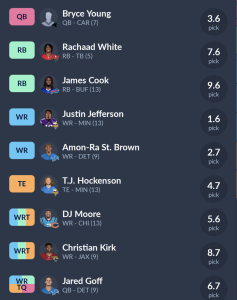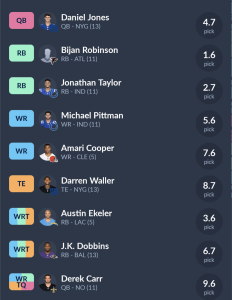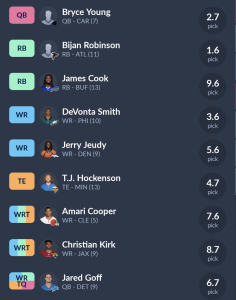One of the best parts of fantasy football is the draft. It’s just exciting! What players are you going to get? Who is going to fall? How are you going to build your team? That last question is one that has been debated for years and is one that there are several approaches to. There are multiple build strategies you can use when it comes to how you want your team to look and this article is going to discuss several of those options that are available to you.
Zero RB
We’re going to get this one out of the way right away because it is the one that feels as though it has been debated the most: Zero RB. This build strategy has teams focusing on all the other starting positions before addressing the running back position. In other words, you would be drafting several wide receivers and typically your tight end and quarterback positions before taking a running back.
With this kind of build, you would not take a running back until you are in the dreaded dead zone, where most of the running backs are questionable in terms of what they will bring in production. This dead zone can be fruitful, but you are typically gambling with whether or not they will be productive when you are taking running backs at this point in the draft. On the flip side of this, you are going to be getting multiple top-end wide receivers that will help carry your team through the season. Here is an example below:
This build has multiple receivers that can produce WR1 numbers, plus a perennial TE1 and two quarterbacks with the potential to carry your team through the playoffs. The running backs are not exactly sexy picks, but they are the lead backs for their teams currently and have the potential to put up solid numbers that will keep your team afloat.
There are a couple of reasons behind going Zero RB. The main reason for those who claim that this is the way to do so is due to the abuse that comes with the running back position. When you are building your team, you want to limit the amount of risk you are taking with your first picks because those are typically going to be the picks that are carrying your team. There are a few ways that are worst than your first pick going down due to injury and tanking your season.
Another reason for the Zero RB build is due to the landscape of the typical NFL backfield. The NFL has slowly been transitioning to a running back by committee (RBBC). It has become more important for fantasy players to adjust their strategy as this transition has become more prevalent. Running backs have become less valuable in these situations, causing the value of the other positions to rise above them. While there is some level of consternation and heated debate around this strategy build, there is some logic behind the approach.
Robust RB
On the opposite end of the Zero RB is the Robust RB approach. This build strategy has fantasy players going heavy on running backs in the early rounds. Rather than waiting, players take several running backs right away and then fill out the rest of their team while the Zero RB drafters wade through the murky depths of the dead zone in hopes of finding slivers of gold. It ensures that your team has several solid bell cow running backs that can fill in just in case one goes down due to injury. Or you can just have your team (literally) run all over the competition. Here is an example of what this build might look like:
With this approach, there are multiple running backs that can put up RB1 numbers and are the lead backs on their team. The tight end situation has a lot of promise in Waller, plus both wide receivers have WR2 or better upside. The depth behind wide receiver and the potential quarterback play could be concerning, but each should be able to hold their own in the playoffs.
The reasoning behind going this route is that there are so few bell cow running backs left in the league that it is important to prioritize them. When everybody else is struggling to find a running back to stream, your team is sitting comfortably with players to plug in without worry every week. Instead of avoiding the problems involved with the running back by committee (RBBC) approach that most teams are going with, you are getting ahead of the situation.
Hero RB
Sitting in between these last two strategies is the Hero RB. This build strategy gives players the flexibility of a Zero RB build while working to avoid some of the problems that are associated with the dead zone. Much like how the name suggests, you take one of the top-tiered running backs to carry your team in that position before turning to the other positions. This is my personal favorite way to build a roster because it has you taking a high-risk/high-reward approach with getting one of the top running backs in the league before you turn your focus to filling the other positions. Here is another example of what this kind of team might look like if you take this approach:
James Cook is the biggest weakness here, but even he is the lead back at his position for the Buffalo Bills. Plus, you’re looking at him more as a flex than as an RB2. He can be swapped out if needed for another late round running back that is producing more throughout the season. This starting lineup gives you multiple targets that have put up number 1 numbers at their positions in the past and have the potential to do so again.
There are other strategies that people take as well, such as Bully TE, where you take multiple tight ends early, or the Christmas Tree, where you rotate back and forth between running backs and wide receivers. Each has its merits, and the debate will continue to rage on until the end of days, I’m sure. What about you? Which strategy build do you prefer to use? Are there any strategies not discussed here that you know of? Let me know in the comments, and I’ll discuss it in a future article.




